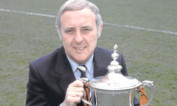
Sir Alex Ferguson unwittingly continues to take a bit of the shine off Dundee United’s only Scottish Championship success.
In 1983, his Aberdeen side won the European Cup-Winners’ Cup just three days before the Tangerines clinched the title.
Now Fergie has decided to retire in the build-up to the Tannadice club’s 30th anniversary celebrations.
But he would not want to diminish the achievement of his pal, Jim McLean, even if the legendary United boss wouldn’t want a fuss.
What I remember most about the day United clinched the title across the road at Dens Park is their manager inviting the Press back to Tannadice for a drink.
‘Wee Jim’ was a strict tee-totaller and didn’t like to see his players drinking, either.
But he was eventually persuaded to take a sip of champagne from the League Championship trophy but not before saying, “Don’t look now, Mum!”
United triumphed by just one point from Celtic and Aberdeen, with Rangers a distant fourth 18 points behind.
McLean’s side also reached the League Cup semi-finals and the quarter-final of the UEFA Cup, playing a total of 55 games.
They were almost glad to be eliminated from the Scottish Cup at the first time of asking by St Mirren!
McLean doesn’t often receive the credit he deserves for moulding such a thrilling team.
It was built on a solid defence of Hamish McAlpine, Richard Gough, Paul Hegarty, Davie Narey and Maurice Malpas.
But it was United’s ruthlessness on the break that really earned admiration all over Europe.
Ralph Milne and Eamonn Bannon were lightning-fast on the flanks, with Paul Sturrock and Davie Dodds the finest pair of predators around.
McLean is sometimes accused of having been a safety-first manager.
United, however, scored 90 goals in 36 League games that season.
He may have been cautious in his early days, but by 1983 McLean had enough good players around him to place the emphasis firmly on attack.
McLean genuinely believed his players were capable of more.
They reached the semi-finals of the European Cup the following season, and only blatant chicanery from Roma prevented them from playing Liverpool in the final.
It would be another 15 years before Sir Alex got Manchester United to that level.

Enjoy the convenience of having The Sunday Post delivered as a digital ePaper straight to your smartphone, tablet or computer.
Subscribe for only £5.49 a month and enjoy all the benefits of the printed paper as a digital replica.
Subscribe